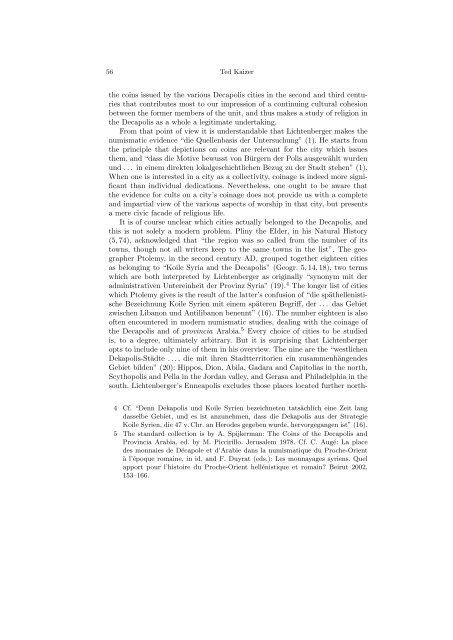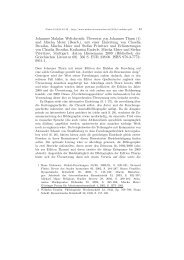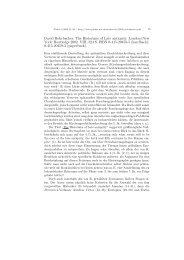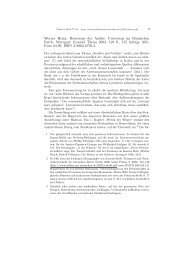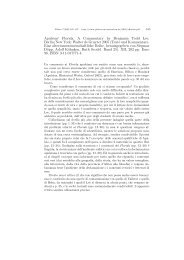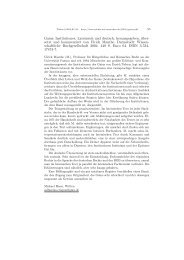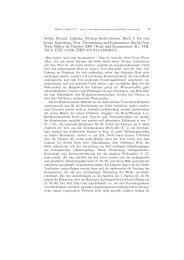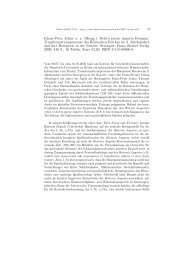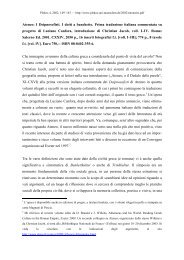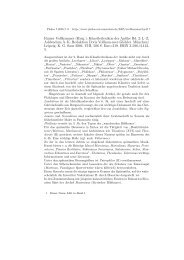Achim Lichtenberger: Kulte und Kultur der Dekapolis ... - Plekos
Achim Lichtenberger: Kulte und Kultur der Dekapolis ... - Plekos
Achim Lichtenberger: Kulte und Kultur der Dekapolis ... - Plekos
You also want an ePaper? Increase the reach of your titles
YUMPU automatically turns print PDFs into web optimized ePapers that Google loves.
56 Ted Kaizer<br />
the coins issued by the various Decapolis cities in the second and third centuries<br />
that contributes most to our impression of a continuing cultural cohesion<br />
between the former members of the unit, and thus makes a study of religion in<br />
the Decapolis as a whole a legitimate <strong>und</strong>ertaking.<br />
From that point of view it is <strong>und</strong>erstandable that <strong>Lichtenberger</strong> makes the<br />
numismatic evidence “die Quellenbasis <strong>der</strong> Untersuchung” (1). He starts from<br />
the principle that depictions on coins are relevant for the city which issues<br />
them, and “dass die Motive bewusst von Bürgern <strong>der</strong> Polis ausgewählt wurden<br />
<strong>und</strong> . . . in einem direkten lokalgeschichtlichen Bezug zu <strong>der</strong> Stadt stehen” (1).<br />
When one is interested in a city as a collectivity, coinage is indeed more significant<br />
than individual dedications. Nevertheless, one ought to be aware that<br />
the evidence for cults on a city’s coinage does not provide us with a complete<br />
and impartial view of the various aspects of worship in that city, but presents<br />
a mere civic facade of religious life.<br />
It is of course unclear which cities actually belonged to the Decapolis, and<br />
this is not solely a mo<strong>der</strong>n problem. Pliny the El<strong>der</strong>, in his Natural History<br />
(5, 74), acknowledged that “the region was so called from the number of its<br />
towns, though not all writers keep to the same towns in the list”. The geographer<br />
Ptolemy, in the second century AD, grouped together eighteen cities<br />
as belonging to “Koile Syria and the Decapolis” (Geogr. 5, 14, 18), two terms<br />
which are both interpreted by <strong>Lichtenberger</strong> as originally “synonym mit <strong>der</strong><br />
administrativen Untereinheit <strong>der</strong> Provinz Syria” (19). 4 The longer list of cities<br />
which Ptolemy gives is the result of the latter’s confusion of “die späthellenistische<br />
Bezeichnung Koile Syrien mit einem späteren Begriff, <strong>der</strong> . . . das Gebiet<br />
zwischen Libanon <strong>und</strong> Antilibanon benennt” (16). The number eighteen is also<br />
often encountered in mo<strong>der</strong>n numismatic studies, dealing with the coinage of<br />
the Decapolis and of provincia Arabia. 5 Every choice of cities to be studied<br />
is, to a degree, ultimately arbitrary. But it is surprising that <strong>Lichtenberger</strong><br />
opts to include only nine of them in his overview. The nine are the “westlichen<br />
<strong>Dekapolis</strong>-Städte . . . , die mit ihren Stadtterritorien ein zusammenhängendes<br />
Gebiet bilden” (20): Hippos, Dion, Abila, Gadara and Capitolias in the north,<br />
Scythopolis and Pella in the Jordan valley, and Gerasa and Philadelphia in the<br />
south. <strong>Lichtenberger</strong>’s Enneapolis excludes those places located further north-<br />
4 Cf. “Denn <strong>Dekapolis</strong> <strong>und</strong> Koile Syrien bezeichneten tatsächlich eine Zeit lang<br />
dasselbe Gebiet, <strong>und</strong> es ist anzunehmen, dass die <strong>Dekapolis</strong> aus <strong>der</strong> Strategie<br />
Koile Syrien, die 47 v. Chr. an Herodes gegeben wurde, hervorgegangen ist” (16).<br />
5 The standard collection is by A. Spijkerman: The Coins of the Decapolis and<br />
Provincia Arabia, ed. by M. Piccirillo. Jerusalem 1978. Cf. C. Augé: La place<br />
des monnaies de Décapole et d’Arabie dans la numismatique du Proche-Orient<br />
à l’époque romaine, in id. and F. Duyrat (eds.): Les monnayages syriens. Quel<br />
apport pour l’histoire du Proche-Orient hellénistique et romain? Beirut 2002,<br />
153–166.


